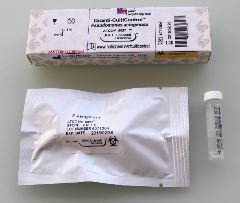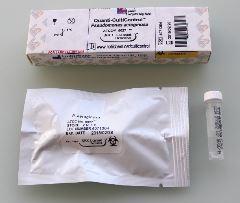(QC resist KPC) ATCC BAA-1705,K PNEUMONIAE, 5 pellets,µtube
Valid Article
RESISTANCE QUALITY CONTROL MICROORGANISM
Definition
Phenotypically characterized resistant strains that are developped according to the recommendation of/made available by the European Society of Clinical Microbiology and Infectious Diseases (EUCAST) for quality control.
The microbial strains have specific resistance mechanisms (ESBL, MRSA, ...) and phenotypically reproducible levels of susceptibility.
They are lyophilized into pellets.
The microbial strain preparations are derived from ATCC® (American Type Culture Collection), NCTC® (National Collection of Type Cultures, operated by the UK Health Security Agency (UKHSA)
Specifications
- ATCC 700603/NCTC 13368 KLEBSIELLA PNEUMONIAE:
- ESBL (Extended-Spectrum β-Lactamase) production in Enterobacteriaceae
- NTCT 12493 S AUREUS:
- methicillin resistance in Staphylococcus aureus
- ATCC 51299 ENTEROCOCCUS FAECALIS:
- vanB-mediated glycopeptide resistance in enterococci
- high-level aminoglycoside resistance in enterococci
- ATCC 49247 HAEMOPHILUS INFLUENZA:
- reduced susceptibility to ß-lactam agents due to PBP mutations in Haemophilus influenzae
- ATCC BAA-1705 KLEBSIELLA PNEUMONIAE:
- carbapenemase producer
Quality Standards Comment
EUCAST recommendations - version 8
Components
The quality control microorganisms are packaged in a resealable vial that contains five lyophilized pellets of a single microorganism strain and a desiccant to prevent adverse accumulation of moisture
Technical specifications
- Freeze dried bacterial strains
- ATCC: Each lyophilized microorganism preparation is less than or equal to four (4) passages from a reference culture.
- Microorganisms for standard protocols should be used within five passages of the ATCC reference culture.
Packaging & Labelling
1 vial contains 5 lyophilized pellets
Transport Dangerous Goods
- UN3373
- Class 6.2
- Proper shipping name: Biological substance, Category B
Instructions for use
Please consult the “Bacteriology laboratory procedures and resources” available online via the Laboratory working Group sharepoint page: Laboratory Procedures and Resources https://msfintl.sharepoint.com/sites/msfintlcommunities/LabWG/SitePages/Bacteriology-Laboratory-Resources.aspx
For offline access, contact your laboratory advisor
Precautions for Use
All biological samples must be considered as potentially infectious and handled with the usual precautions (compulsory wearing of gloves, hand washing, etc.)
Storage
- Store between 2°C and 8°C, with desiccant
- Store at -20°C to -80°C after suspension in brain heart infusion broth and glycerol
- Do not use after expiry date
- Shelf life: ATCC: 16 months
- Guaranteed minimum remaining shelf life at delivery: 1/3 of the total shelf life
Waste management
After use, sterilize the cultures and all contaminated material
Substance with biohazardous characteristics. Please contact your watsan referent for advice on proper disposal.
Detailed hazard and precautionary information can be found in the safety data sheet (SDS).
Signal Word
Biohazard
MSF requirements
Reserved for bacteriology programmes





![[ELABFOBR1--] FORCEPS, BRUCELLE, 14 cm, straight, inox](/web/image/product.template/570435/image_256/%5BELABFOBR1--%5D%20FORCEPS%2C%20BRUCELLE%2C%2014%20cm%2C%20straight%2C%20inox?unique=6ad59f9)
![[ELABTUCE1SPC] TUBE, CENTRIFUGE, 15 ml, conical bottom, sterile PS crystal](/web/image/product.template/571492/image_256/%5BELABTUCE1SPC%5D%20TUBE%2C%20CENTRIFUGE%2C%2015%20ml%2C%20conical%20bottom%2C%20sterile%20PS%20crystal?unique=1bdf911)
![[ELABTUMS20AS] MICROTUBE, 2.0ml, skirted, assembl. attach. screw cap, ster.](/web/image/product.template/569078/image_256/%5BELABTUMS20AS%5D%20MICROTUBE%2C%202.0ml%2C%20skirted%2C%20assembl.%20attach.%20screw%20cap%2C%20ster.?unique=de865de)
![[SBCMBRTHBHIBD] BRAIN HEART INFUSION BROTH, dehydrated, 500g [BD-211059]](/web/image/product.template/572079/image_256/%5BSBCMBRTHBHIBD%5D%20BRAIN%20HEART%20INFUSION%20BROTH%2C%20dehydrated%2C%20500g%20%5BBD-211059%5D?unique=3a0c5c0)
![[SLASGLYC1B1] GLYCEROL, 1 l, bot.](/web/image/product.template/570450/image_256/%5BSLASGLYC1B1%5D%20GLYCEROL%2C%201%20l%2C%20bot.?unique=73d4cbb)
![[SBQCKWIKKLPN2] (QC resist KPC) ATCC BAA-1705, K PNEUMONIAE, sw.[MBL-01005P]](/web/image/product.template/580154/image_256/%5BSBQCKWIKKLPN2%5D%20%28QC%20resist%20KPC%29%20ATCC%20BAA-1705%2C%20K%20PNEUMONIAE%2C%20sw.%5BMBL-01005P%5D?unique=280b85b)